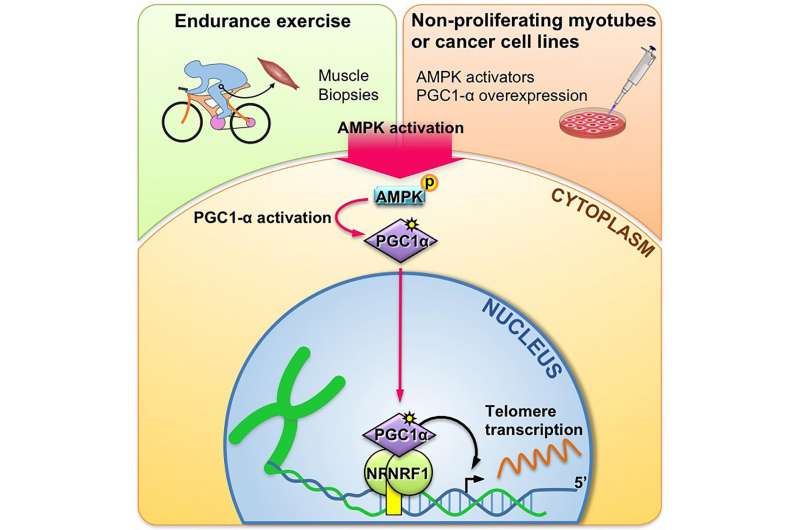The age-dependent loss of telomere integrity limits the replicative capacities of our tissues. The study by Diman et al. shows that endurance exercise stimulates telomere transcription into long non-coding RNA molecules with important functions at telomeres. This process, dependent on the AMPK/PGC-1alpha/NRF1 metabolic pathway, is likely to contribute to telomere protection. Credit: Aurélie Diman and Anabelle Decottignies
(Medical Xpress)—A team of researchers with members from several institutions in Belgium has found that endurance exercise may play a role in the regulation of telomere transcription. In their paper published in the journal Science Advances, the team describes their study of volunteers exercising, their findings, and what their results might mean for people in general.
Most people know that eating healthy and getting regular exercise can lead indirectly to a healthier life, but until now, there has not been any evidence that doing so has a direct impact on aging and longevity. In this new effort, the researchers report that they have found evidence of endurance exercise releasing chemical factors that may produce a class of molecules that promote longer telomeres, and by extension, slower aging.
Telomeres are caps of repeat–containing RNA (TERRA) on the ends of chromosomes. Prior research has suggested that telomere length is an indicator of a longer life, or more specifically, of aging. People with longer telomeres generally live longer than average, whereas those with shorter telomeres tend to die younger.
To learn more about the connection between exercise and telomere length, the researchers asked 10 volunteers to ride a cycle machine for 45 minutes. The researchers took blood samples and muscle biopsies of each volunteer before and directly after exercising, and then again two and a half hours later.
In studying the samples taken after exercise and comparing them to those taken beforehand, the researchers found an increase of precursors to TERRA molecules and a related increase in activation of AMPK, an enzyme that is known to be part of PGC-1 álpha activation (prior research has found that it interacts with NRF1, which is found in telomeres). These findings suggest that such types of exercise activate the process that is believed to be involved in causing telomeres to lengthen, and thus to slow the aging process.
The researchers acknowledge that simply exercising more is not likely to cause people to live longer; however, there are other factors that play a role as well, including diet, heredity and behaviors such as smoking, drug usage or engaging in risky behavior.
Journal information: Science Advances
© 2016 Medical Xpress























